Asda's Employee Engagement: Diagnostic Tools, Strategies, and Analysis
VerifiedAdded on 2023/01/03
|13
|2659
|84
Report
AI Summary
This report provides a comprehensive overview of employee engagement strategies, focusing on the context of Asda. It begins with an introduction to people management and the concept of employee engagement, exploring the key drivers that influence it, such as employee acknowledgment, decentralized power structures, work-life balance, and transparency. The report then evaluates various diagnostic tools used to measure employee engagement, including the IES engagement model, pulse surveys, 1-on-1 meetings, stay/exit interviews, and the eNPS. Finally, it delves into the analysis of employee value proposition (EVP) strategies designed to enhance engagement levels. The EVP analysis covers essential steps such as assessing the current offer, interviewing employees, defining the main functions of the EVP, preparing and promoting the EVP, and reviewing the results. The report provides a well-rounded understanding of employee engagement within an organizational context.
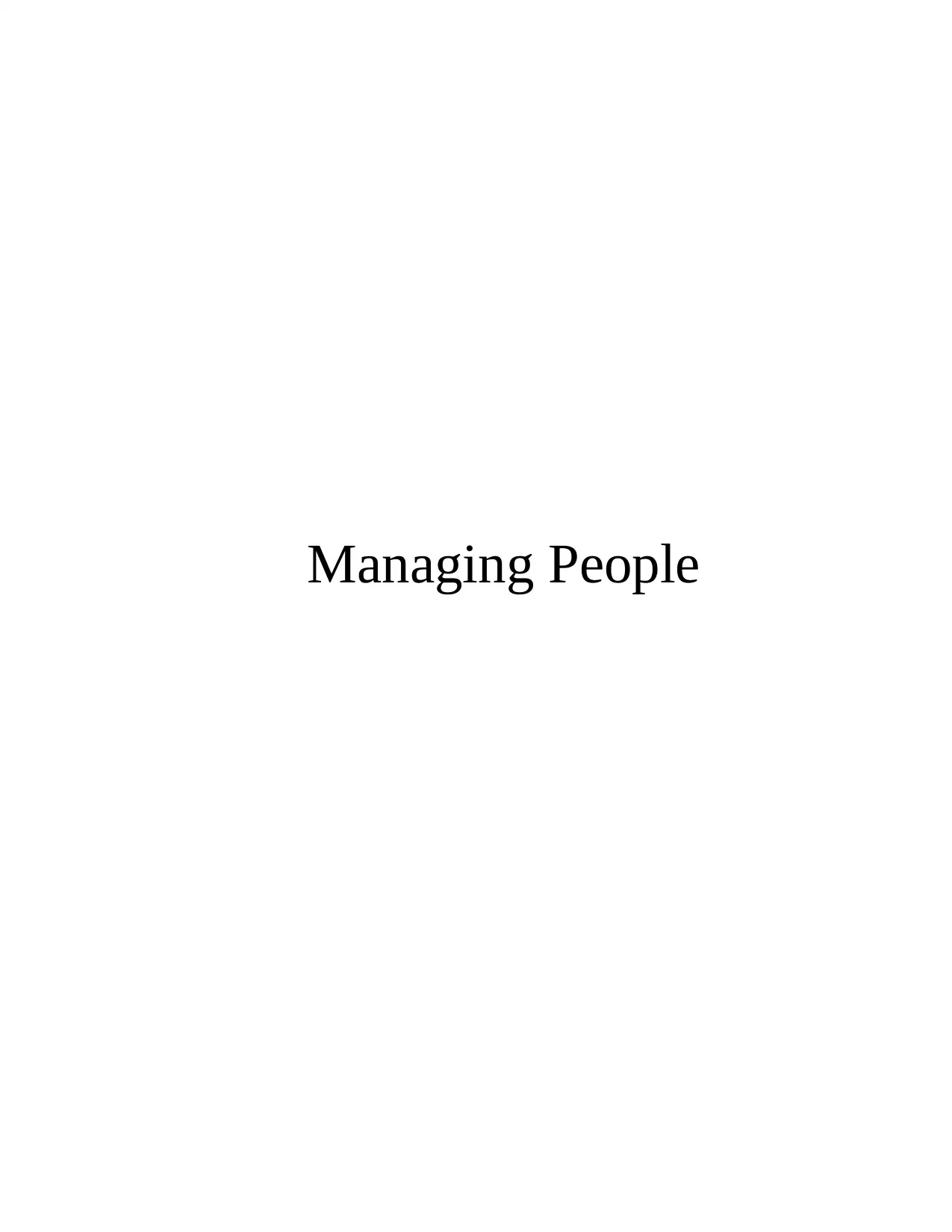
Managing People
Paraphrase This Document
Need a fresh take? Get an instant paraphrase of this document with our AI Paraphraser
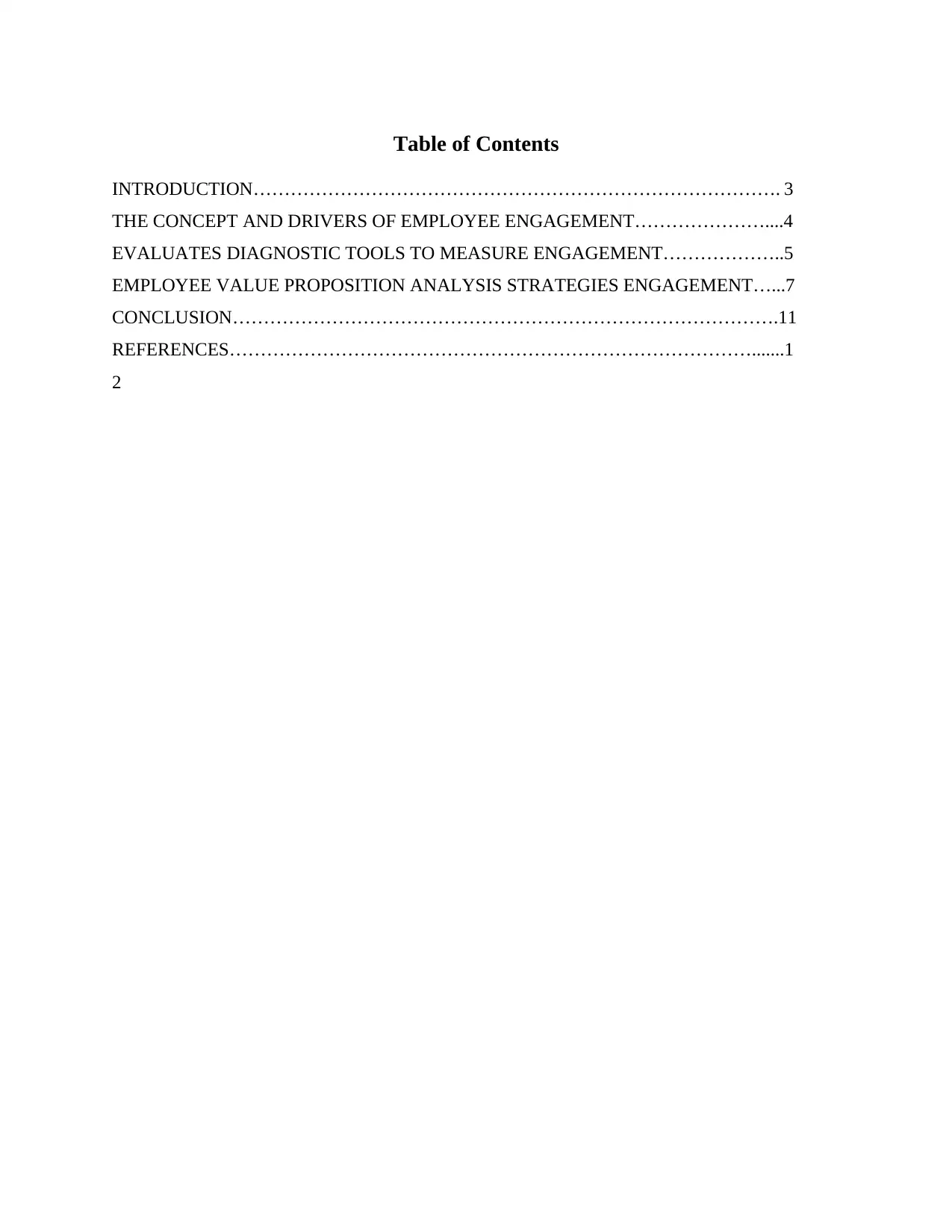
Table of Contents
INTRODUCTION…………………………………………………………………………. 3
THE CONCEPT AND DRIVERS OF EMPLOYEE ENGAGEMENT…………………....4
EVALUATES DIAGNOSTIC TOOLS TO MEASURE ENGAGEMENT………………..5
EMPLOYEE VALUE PROPOSITION ANALYSIS STRATEGIES ENGAGEMENT…...7
CONCLUSION…………………………………………………………………………….11
REFERENCES………………………………………………………………………….......1
2
INTRODUCTION…………………………………………………………………………. 3
THE CONCEPT AND DRIVERS OF EMPLOYEE ENGAGEMENT…………………....4
EVALUATES DIAGNOSTIC TOOLS TO MEASURE ENGAGEMENT………………..5
EMPLOYEE VALUE PROPOSITION ANALYSIS STRATEGIES ENGAGEMENT…...7
CONCLUSION…………………………………………………………………………….11
REFERENCES………………………………………………………………………….......1
2
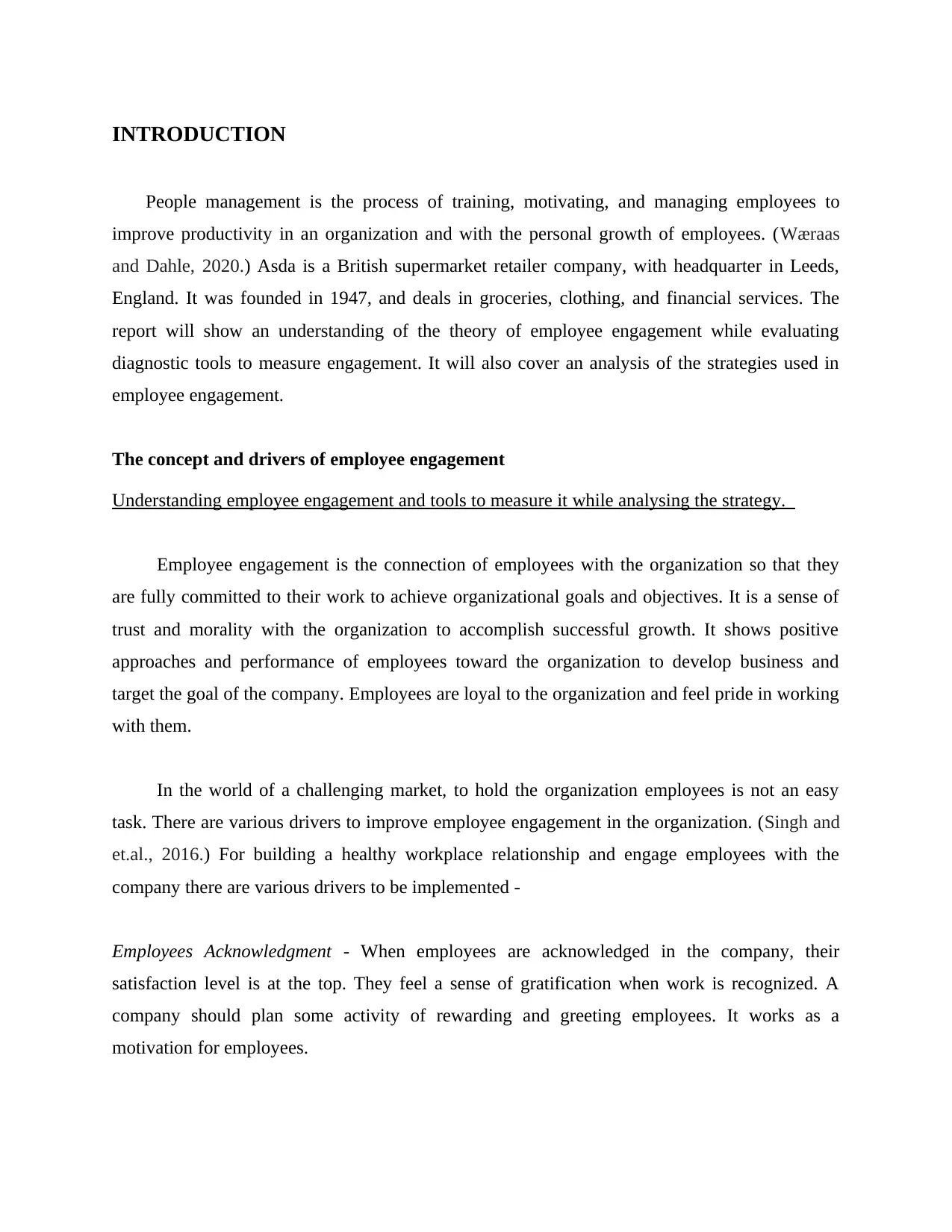
INTRODUCTION
People management is the process of training, motivating, and managing employees to
improve productivity in an organization and with the personal growth of employees. (Wæraas
and Dahle, 2020.) Asda is a British supermarket retailer company, with headquarter in Leeds,
England. It was founded in 1947, and deals in groceries, clothing, and financial services. The
report will show an understanding of the theory of employee engagement while evaluating
diagnostic tools to measure engagement. It will also cover an analysis of the strategies used in
employee engagement.
The concept and drivers of employee engagement
Understanding employee engagement and tools to measure it while analysing the strategy.
Employee engagement is the connection of employees with the organization so that they
are fully committed to their work to achieve organizational goals and objectives. It is a sense of
trust and morality with the organization to accomplish successful growth. It shows positive
approaches and performance of employees toward the organization to develop business and
target the goal of the company. Employees are loyal to the organization and feel pride in working
with them.
In the world of a challenging market, to hold the organization employees is not an easy
task. There are various drivers to improve employee engagement in the organization. (Singh and
et.al., 2016.) For building a healthy workplace relationship and engage employees with the
company there are various drivers to be implemented -
Employees Acknowledgment - When employees are acknowledged in the company, their
satisfaction level is at the top. They feel a sense of gratification when work is recognized. A
company should plan some activity of rewarding and greeting employees. It works as a
motivation for employees.
People management is the process of training, motivating, and managing employees to
improve productivity in an organization and with the personal growth of employees. (Wæraas
and Dahle, 2020.) Asda is a British supermarket retailer company, with headquarter in Leeds,
England. It was founded in 1947, and deals in groceries, clothing, and financial services. The
report will show an understanding of the theory of employee engagement while evaluating
diagnostic tools to measure engagement. It will also cover an analysis of the strategies used in
employee engagement.
The concept and drivers of employee engagement
Understanding employee engagement and tools to measure it while analysing the strategy.
Employee engagement is the connection of employees with the organization so that they
are fully committed to their work to achieve organizational goals and objectives. It is a sense of
trust and morality with the organization to accomplish successful growth. It shows positive
approaches and performance of employees toward the organization to develop business and
target the goal of the company. Employees are loyal to the organization and feel pride in working
with them.
In the world of a challenging market, to hold the organization employees is not an easy
task. There are various drivers to improve employee engagement in the organization. (Singh and
et.al., 2016.) For building a healthy workplace relationship and engage employees with the
company there are various drivers to be implemented -
Employees Acknowledgment - When employees are acknowledged in the company, their
satisfaction level is at the top. They feel a sense of gratification when work is recognized. A
company should plan some activity of rewarding and greeting employees. It works as a
motivation for employees.
⊘ This is a preview!⊘
Do you want full access?
Subscribe today to unlock all pages.

Trusted by 1+ million students worldwide
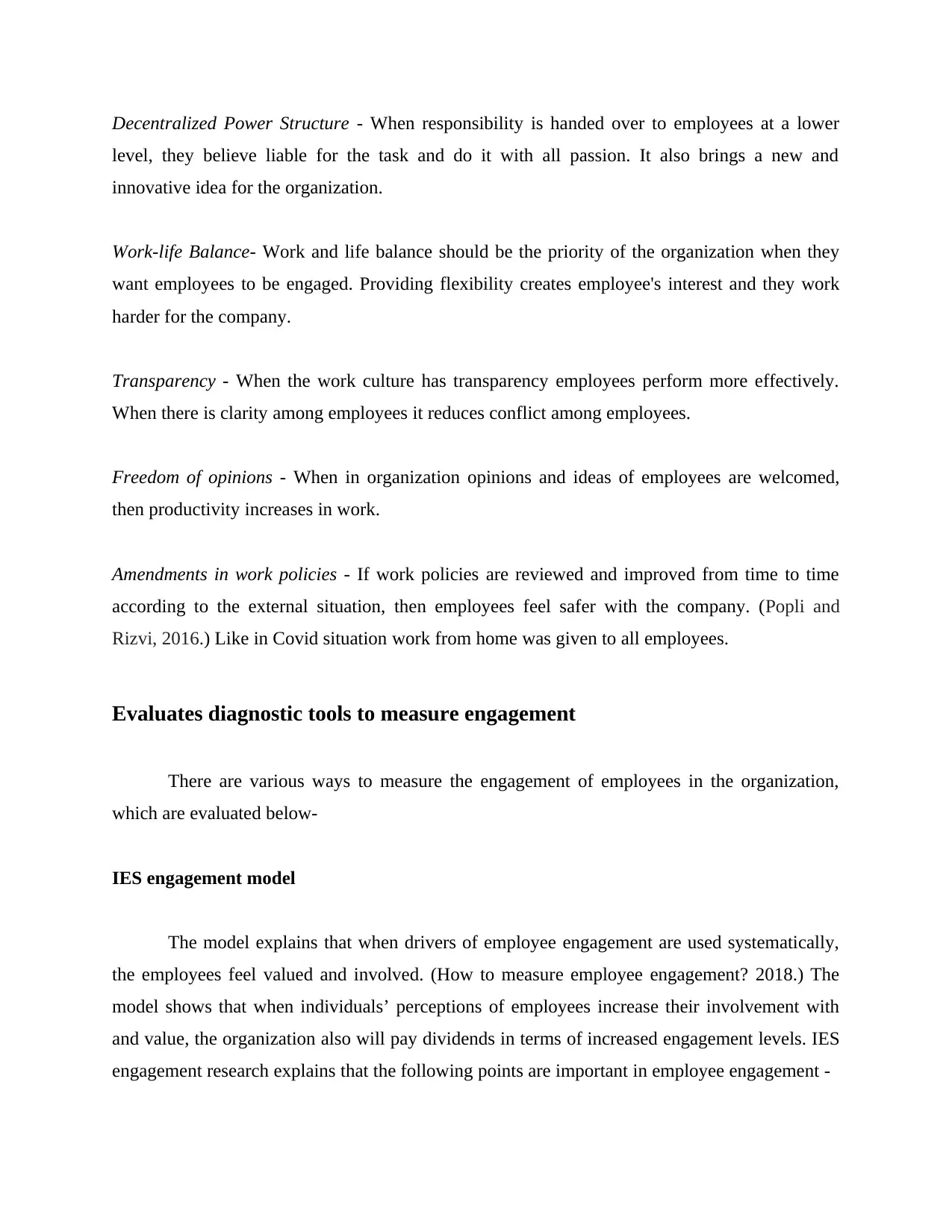
Decentralized Power Structure - When responsibility is handed over to employees at a lower
level, they believe liable for the task and do it with all passion. It also brings a new and
innovative idea for the organization.
Work-life Balance- Work and life balance should be the priority of the organization when they
want employees to be engaged. Providing flexibility creates employee's interest and they work
harder for the company.
Transparency - When the work culture has transparency employees perform more effectively.
When there is clarity among employees it reduces conflict among employees.
Freedom of opinions - When in organization opinions and ideas of employees are welcomed,
then productivity increases in work.
Amendments in work policies - If work policies are reviewed and improved from time to time
according to the external situation, then employees feel safer with the company. (Popli and
Rizvi, 2016.) Like in Covid situation work from home was given to all employees.
Evaluates diagnostic tools to measure engagement
There are various ways to measure the engagement of employees in the organization,
which are evaluated below-
IES engagement model
The model explains that when drivers of employee engagement are used systematically,
the employees feel valued and involved. (How to measure employee engagement? 2018.) The
model shows that when individuals’ perceptions of employees increase their involvement with
and value, the organization also will pay dividends in terms of increased engagement levels. IES
engagement research explains that the following points are important in employee engagement -
level, they believe liable for the task and do it with all passion. It also brings a new and
innovative idea for the organization.
Work-life Balance- Work and life balance should be the priority of the organization when they
want employees to be engaged. Providing flexibility creates employee's interest and they work
harder for the company.
Transparency - When the work culture has transparency employees perform more effectively.
When there is clarity among employees it reduces conflict among employees.
Freedom of opinions - When in organization opinions and ideas of employees are welcomed,
then productivity increases in work.
Amendments in work policies - If work policies are reviewed and improved from time to time
according to the external situation, then employees feel safer with the company. (Popli and
Rizvi, 2016.) Like in Covid situation work from home was given to all employees.
Evaluates diagnostic tools to measure engagement
There are various ways to measure the engagement of employees in the organization,
which are evaluated below-
IES engagement model
The model explains that when drivers of employee engagement are used systematically,
the employees feel valued and involved. (How to measure employee engagement? 2018.) The
model shows that when individuals’ perceptions of employees increase their involvement with
and value, the organization also will pay dividends in terms of increased engagement levels. IES
engagement research explains that the following points are important in employee engagement -
Paraphrase This Document
Need a fresh take? Get an instant paraphrase of this document with our AI Paraphraser
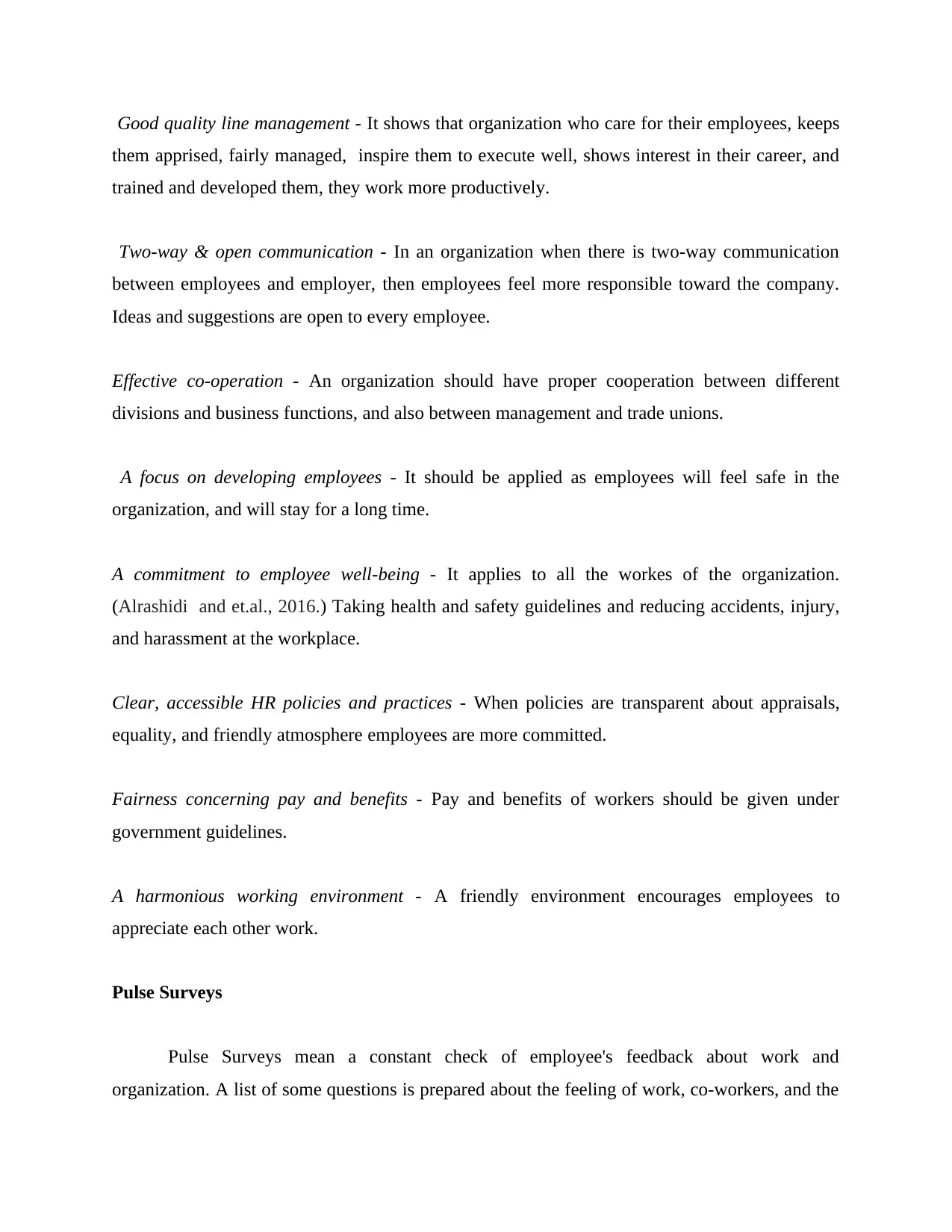
Good quality line management - It shows that organization who care for their employees, keeps
them apprised, fairly managed, inspire them to execute well, shows interest in their career, and
trained and developed them, they work more productively.
Two-way & open communication - In an organization when there is two-way communication
between employees and employer, then employees feel more responsible toward the company.
Ideas and suggestions are open to every employee.
Effective co-operation - An organization should have proper cooperation between different
divisions and business functions, and also between management and trade unions.
A focus on developing employees - It should be applied as employees will feel safe in the
organization, and will stay for a long time.
A commitment to employee well-being - It applies to all the workes of the organization.
(Alrashidi and et.al., 2016.) Taking health and safety guidelines and reducing accidents, injury,
and harassment at the workplace.
Clear, accessible HR policies and practices - When policies are transparent about appraisals,
equality, and friendly atmosphere employees are more committed.
Fairness concerning pay and benefits - Pay and benefits of workers should be given under
government guidelines.
A harmonious working environment - A friendly environment encourages employees to
appreciate each other work.
Pulse Surveys
Pulse Surveys mean a constant check of employee's feedback about work and
organization. A list of some questions is prepared about the feeling of work, co-workers, and the
them apprised, fairly managed, inspire them to execute well, shows interest in their career, and
trained and developed them, they work more productively.
Two-way & open communication - In an organization when there is two-way communication
between employees and employer, then employees feel more responsible toward the company.
Ideas and suggestions are open to every employee.
Effective co-operation - An organization should have proper cooperation between different
divisions and business functions, and also between management and trade unions.
A focus on developing employees - It should be applied as employees will feel safe in the
organization, and will stay for a long time.
A commitment to employee well-being - It applies to all the workes of the organization.
(Alrashidi and et.al., 2016.) Taking health and safety guidelines and reducing accidents, injury,
and harassment at the workplace.
Clear, accessible HR policies and practices - When policies are transparent about appraisals,
equality, and friendly atmosphere employees are more committed.
Fairness concerning pay and benefits - Pay and benefits of workers should be given under
government guidelines.
A harmonious working environment - A friendly environment encourages employees to
appreciate each other work.
Pulse Surveys
Pulse Surveys mean a constant check of employee's feedback about work and
organization. A list of some questions is prepared about the feeling of work, co-workers, and the
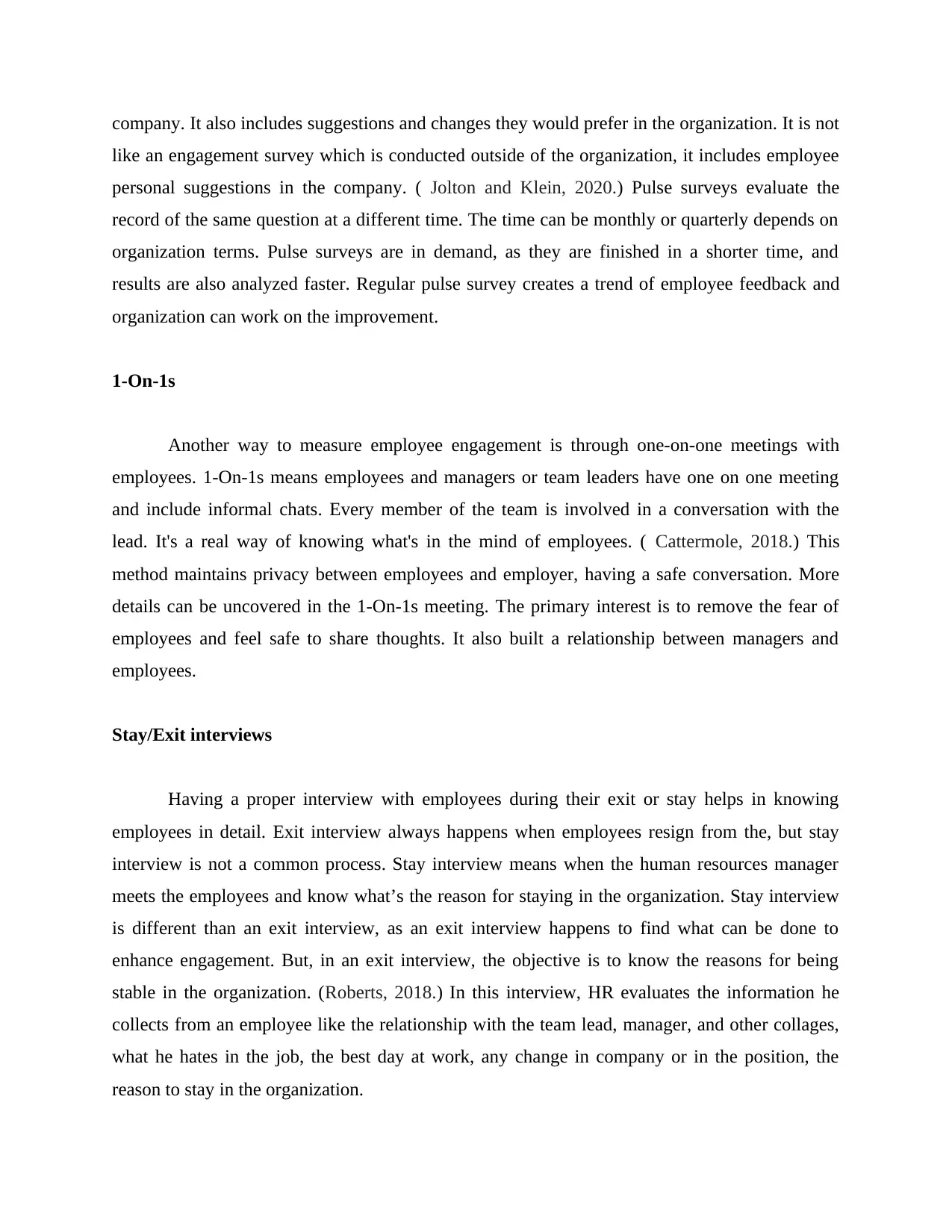
company. It also includes suggestions and changes they would prefer in the organization. It is not
like an engagement survey which is conducted outside of the organization, it includes employee
personal suggestions in the company. ( Jolton and Klein, 2020.) Pulse surveys evaluate the
record of the same question at a different time. The time can be monthly or quarterly depends on
organization terms. Pulse surveys are in demand, as they are finished in a shorter time, and
results are also analyzed faster. Regular pulse survey creates a trend of employee feedback and
organization can work on the improvement.
1-On-1s
Another way to measure employee engagement is through one-on-one meetings with
employees. 1-On-1s means employees and managers or team leaders have one on one meeting
and include informal chats. Every member of the team is involved in a conversation with the
lead. It's a real way of knowing what's in the mind of employees. ( Cattermole, 2018.) This
method maintains privacy between employees and employer, having a safe conversation. More
details can be uncovered in the 1-On-1s meeting. The primary interest is to remove the fear of
employees and feel safe to share thoughts. It also built a relationship between managers and
employees.
Stay/Exit interviews
Having a proper interview with employees during their exit or stay helps in knowing
employees in detail. Exit interview always happens when employees resign from the, but stay
interview is not a common process. Stay interview means when the human resources manager
meets the employees and know what’s the reason for staying in the organization. Stay interview
is different than an exit interview, as an exit interview happens to find what can be done to
enhance engagement. But, in an exit interview, the objective is to know the reasons for being
stable in the organization. (Roberts, 2018.) In this interview, HR evaluates the information he
collects from an employee like the relationship with the team lead, manager, and other collages,
what he hates in the job, the best day at work, any change in company or in the position, the
reason to stay in the organization.
like an engagement survey which is conducted outside of the organization, it includes employee
personal suggestions in the company. ( Jolton and Klein, 2020.) Pulse surveys evaluate the
record of the same question at a different time. The time can be monthly or quarterly depends on
organization terms. Pulse surveys are in demand, as they are finished in a shorter time, and
results are also analyzed faster. Regular pulse survey creates a trend of employee feedback and
organization can work on the improvement.
1-On-1s
Another way to measure employee engagement is through one-on-one meetings with
employees. 1-On-1s means employees and managers or team leaders have one on one meeting
and include informal chats. Every member of the team is involved in a conversation with the
lead. It's a real way of knowing what's in the mind of employees. ( Cattermole, 2018.) This
method maintains privacy between employees and employer, having a safe conversation. More
details can be uncovered in the 1-On-1s meeting. The primary interest is to remove the fear of
employees and feel safe to share thoughts. It also built a relationship between managers and
employees.
Stay/Exit interviews
Having a proper interview with employees during their exit or stay helps in knowing
employees in detail. Exit interview always happens when employees resign from the, but stay
interview is not a common process. Stay interview means when the human resources manager
meets the employees and know what’s the reason for staying in the organization. Stay interview
is different than an exit interview, as an exit interview happens to find what can be done to
enhance engagement. But, in an exit interview, the objective is to know the reasons for being
stable in the organization. (Roberts, 2018.) In this interview, HR evaluates the information he
collects from an employee like the relationship with the team lead, manager, and other collages,
what he hates in the job, the best day at work, any change in company or in the position, the
reason to stay in the organization.
⊘ This is a preview!⊘
Do you want full access?
Subscribe today to unlock all pages.

Trusted by 1+ million students worldwide
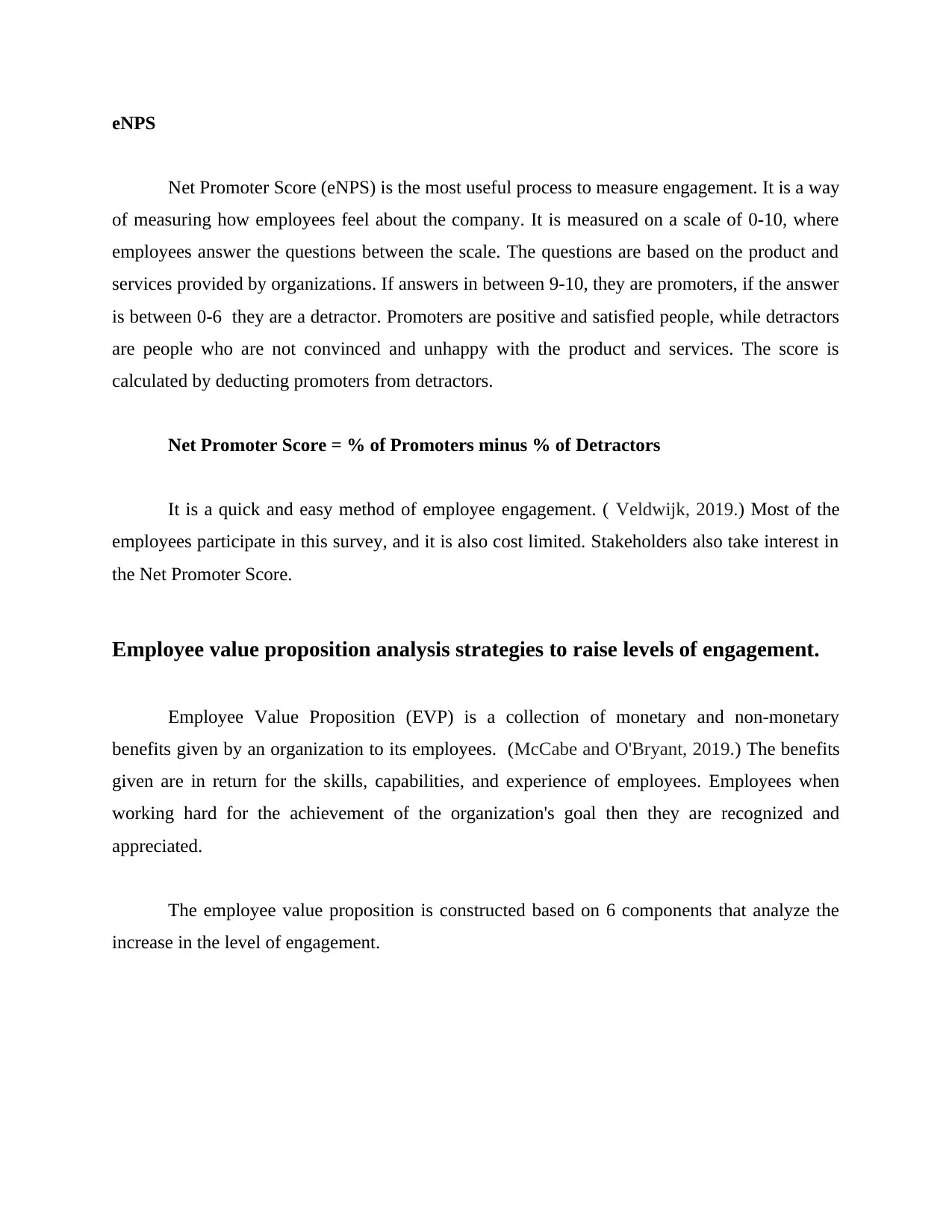
eNPS
Net Promoter Score (eNPS) is the most useful process to measure engagement. It is a way
of measuring how employees feel about the company. It is measured on a scale of 0-10, where
employees answer the questions between the scale. The questions are based on the product and
services provided by organizations. If answers in between 9-10, they are promoters, if the answer
is between 0-6 they are a detractor. Promoters are positive and satisfied people, while detractors
are people who are not convinced and unhappy with the product and services. The score is
calculated by deducting promoters from detractors.
Net Promoter Score = % of Promoters minus % of Detractors
It is a quick and easy method of employee engagement. ( Veldwijk, 2019.) Most of the
employees participate in this survey, and it is also cost limited. Stakeholders also take interest in
the Net Promoter Score.
Employee value proposition analysis strategies to raise levels of engagement.
Employee Value Proposition (EVP) is a collection of monetary and non-monetary
benefits given by an organization to its employees. (McCabe and O'Bryant, 2019.) The benefits
given are in return for the skills, capabilities, and experience of employees. Employees when
working hard for the achievement of the organization's goal then they are recognized and
appreciated.
The employee value proposition is constructed based on 6 components that analyze the
increase in the level of engagement.
Net Promoter Score (eNPS) is the most useful process to measure engagement. It is a way
of measuring how employees feel about the company. It is measured on a scale of 0-10, where
employees answer the questions between the scale. The questions are based on the product and
services provided by organizations. If answers in between 9-10, they are promoters, if the answer
is between 0-6 they are a detractor. Promoters are positive and satisfied people, while detractors
are people who are not convinced and unhappy with the product and services. The score is
calculated by deducting promoters from detractors.
Net Promoter Score = % of Promoters minus % of Detractors
It is a quick and easy method of employee engagement. ( Veldwijk, 2019.) Most of the
employees participate in this survey, and it is also cost limited. Stakeholders also take interest in
the Net Promoter Score.
Employee value proposition analysis strategies to raise levels of engagement.
Employee Value Proposition (EVP) is a collection of monetary and non-monetary
benefits given by an organization to its employees. (McCabe and O'Bryant, 2019.) The benefits
given are in return for the skills, capabilities, and experience of employees. Employees when
working hard for the achievement of the organization's goal then they are recognized and
appreciated.
The employee value proposition is constructed based on 6 components that analyze the
increase in the level of engagement.
Paraphrase This Document
Need a fresh take? Get an instant paraphrase of this document with our AI Paraphraser
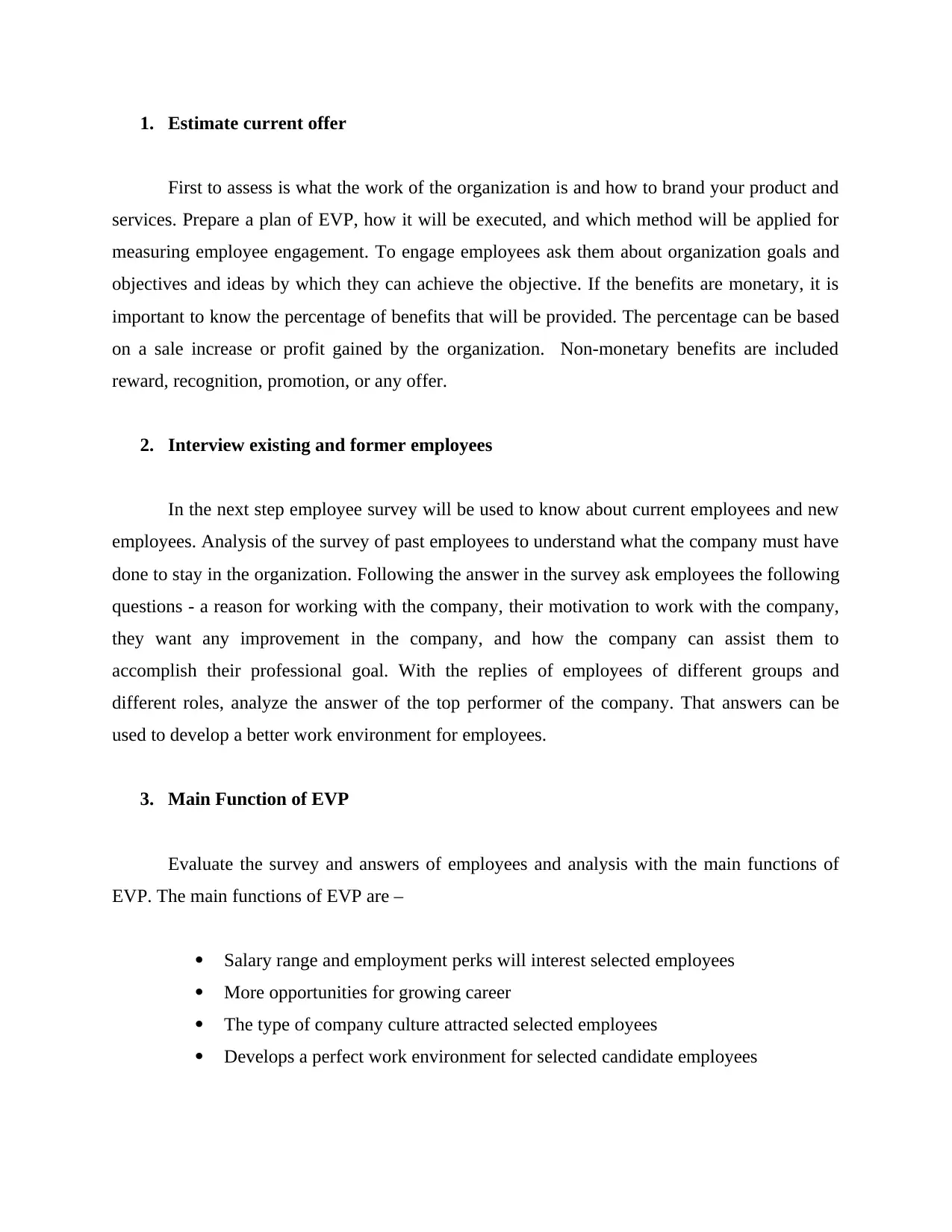
1. Estimate current offer
First to assess is what the work of the organization is and how to brand your product and
services. Prepare a plan of EVP, how it will be executed, and which method will be applied for
measuring employee engagement. To engage employees ask them about organization goals and
objectives and ideas by which they can achieve the objective. If the benefits are monetary, it is
important to know the percentage of benefits that will be provided. The percentage can be based
on a sale increase or profit gained by the organization. Non-monetary benefits are included
reward, recognition, promotion, or any offer.
2. Interview existing and former employees
In the next step employee survey will be used to know about current employees and new
employees. Analysis of the survey of past employees to understand what the company must have
done to stay in the organization. Following the answer in the survey ask employees the following
questions - a reason for working with the company, their motivation to work with the company,
they want any improvement in the company, and how the company can assist them to
accomplish their professional goal. With the replies of employees of different groups and
different roles, analyze the answer of the top performer of the company. That answers can be
used to develop a better work environment for employees.
3. Main Function of EVP
Evaluate the survey and answers of employees and analysis with the main functions of
EVP. The main functions of EVP are –
Salary range and employment perks will interest selected employees
More opportunities for growing career
The type of company culture attracted selected employees
Develops a perfect work environment for selected candidate employees
First to assess is what the work of the organization is and how to brand your product and
services. Prepare a plan of EVP, how it will be executed, and which method will be applied for
measuring employee engagement. To engage employees ask them about organization goals and
objectives and ideas by which they can achieve the objective. If the benefits are monetary, it is
important to know the percentage of benefits that will be provided. The percentage can be based
on a sale increase or profit gained by the organization. Non-monetary benefits are included
reward, recognition, promotion, or any offer.
2. Interview existing and former employees
In the next step employee survey will be used to know about current employees and new
employees. Analysis of the survey of past employees to understand what the company must have
done to stay in the organization. Following the answer in the survey ask employees the following
questions - a reason for working with the company, their motivation to work with the company,
they want any improvement in the company, and how the company can assist them to
accomplish their professional goal. With the replies of employees of different groups and
different roles, analyze the answer of the top performer of the company. That answers can be
used to develop a better work environment for employees.
3. Main Function of EVP
Evaluate the survey and answers of employees and analysis with the main functions of
EVP. The main functions of EVP are –
Salary range and employment perks will interest selected employees
More opportunities for growing career
The type of company culture attracted selected employees
Develops a perfect work environment for selected candidate employees
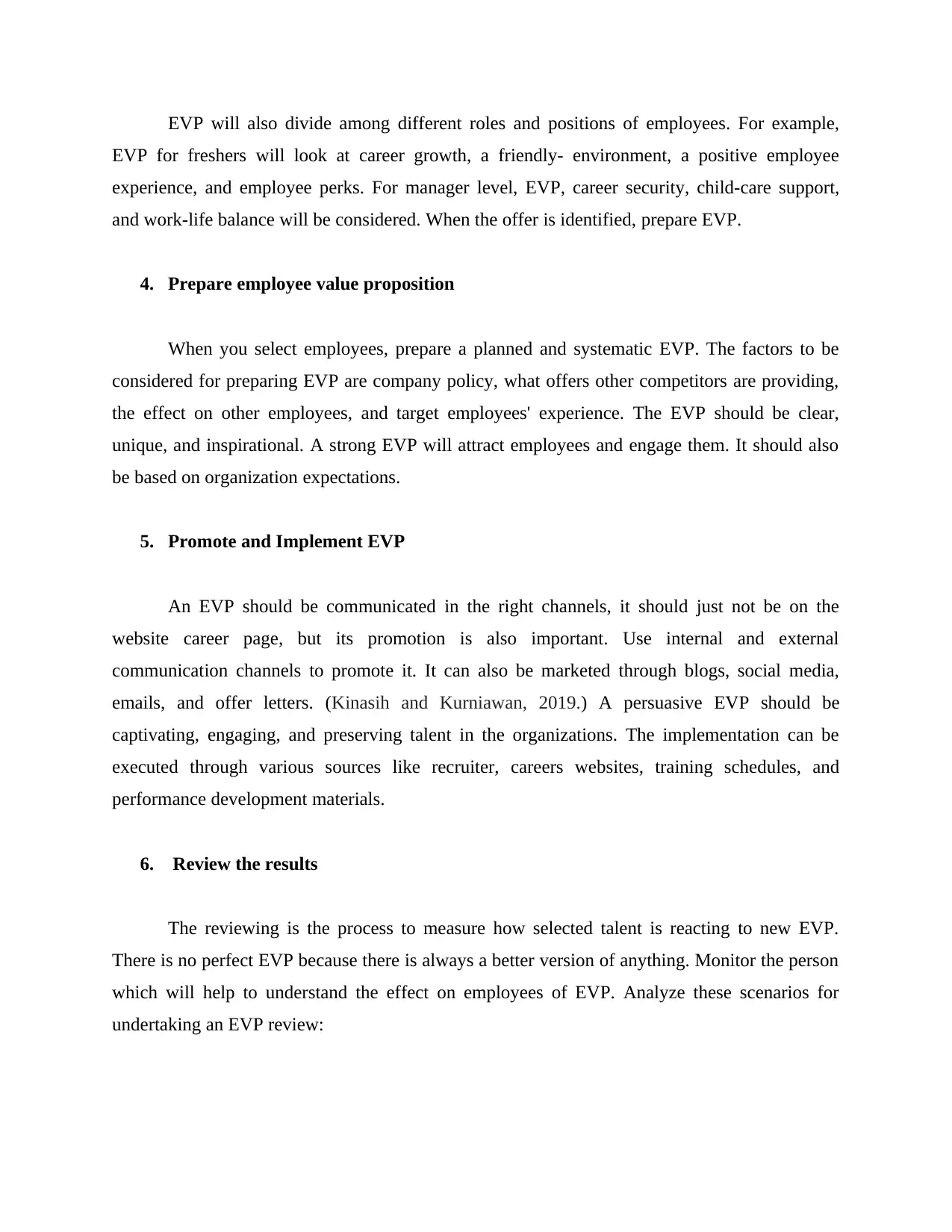
EVP will also divide among different roles and positions of employees. For example,
EVP for freshers will look at career growth, a friendly- environment, a positive employee
experience, and employee perks. For manager level, EVP, career security, child-care support,
and work-life balance will be considered. When the offer is identified, prepare EVP.
4. Prepare employee value proposition
When you select employees, prepare a planned and systematic EVP. The factors to be
considered for preparing EVP are company policy, what offers other competitors are providing,
the effect on other employees, and target employees' experience. The EVP should be clear,
unique, and inspirational. A strong EVP will attract employees and engage them. It should also
be based on organization expectations.
5. Promote and Implement EVP
An EVP should be communicated in the right channels, it should just not be on the
website career page, but its promotion is also important. Use internal and external
communication channels to promote it. It can also be marketed through blogs, social media,
emails, and offer letters. (Kinasih and Kurniawan, 2019.) A persuasive EVP should be
captivating, engaging, and preserving talent in the organizations. The implementation can be
executed through various sources like recruiter, careers websites, training schedules, and
performance development materials.
6. Review the results
The reviewing is the process to measure how selected talent is reacting to new EVP.
There is no perfect EVP because there is always a better version of anything. Monitor the person
which will help to understand the effect on employees of EVP. Analyze these scenarios for
undertaking an EVP review:
EVP for freshers will look at career growth, a friendly- environment, a positive employee
experience, and employee perks. For manager level, EVP, career security, child-care support,
and work-life balance will be considered. When the offer is identified, prepare EVP.
4. Prepare employee value proposition
When you select employees, prepare a planned and systematic EVP. The factors to be
considered for preparing EVP are company policy, what offers other competitors are providing,
the effect on other employees, and target employees' experience. The EVP should be clear,
unique, and inspirational. A strong EVP will attract employees and engage them. It should also
be based on organization expectations.
5. Promote and Implement EVP
An EVP should be communicated in the right channels, it should just not be on the
website career page, but its promotion is also important. Use internal and external
communication channels to promote it. It can also be marketed through blogs, social media,
emails, and offer letters. (Kinasih and Kurniawan, 2019.) A persuasive EVP should be
captivating, engaging, and preserving talent in the organizations. The implementation can be
executed through various sources like recruiter, careers websites, training schedules, and
performance development materials.
6. Review the results
The reviewing is the process to measure how selected talent is reacting to new EVP.
There is no perfect EVP because there is always a better version of anything. Monitor the person
which will help to understand the effect on employees of EVP. Analyze these scenarios for
undertaking an EVP review:
⊘ This is a preview!⊘
Do you want full access?
Subscribe today to unlock all pages.

Trusted by 1+ million students worldwide
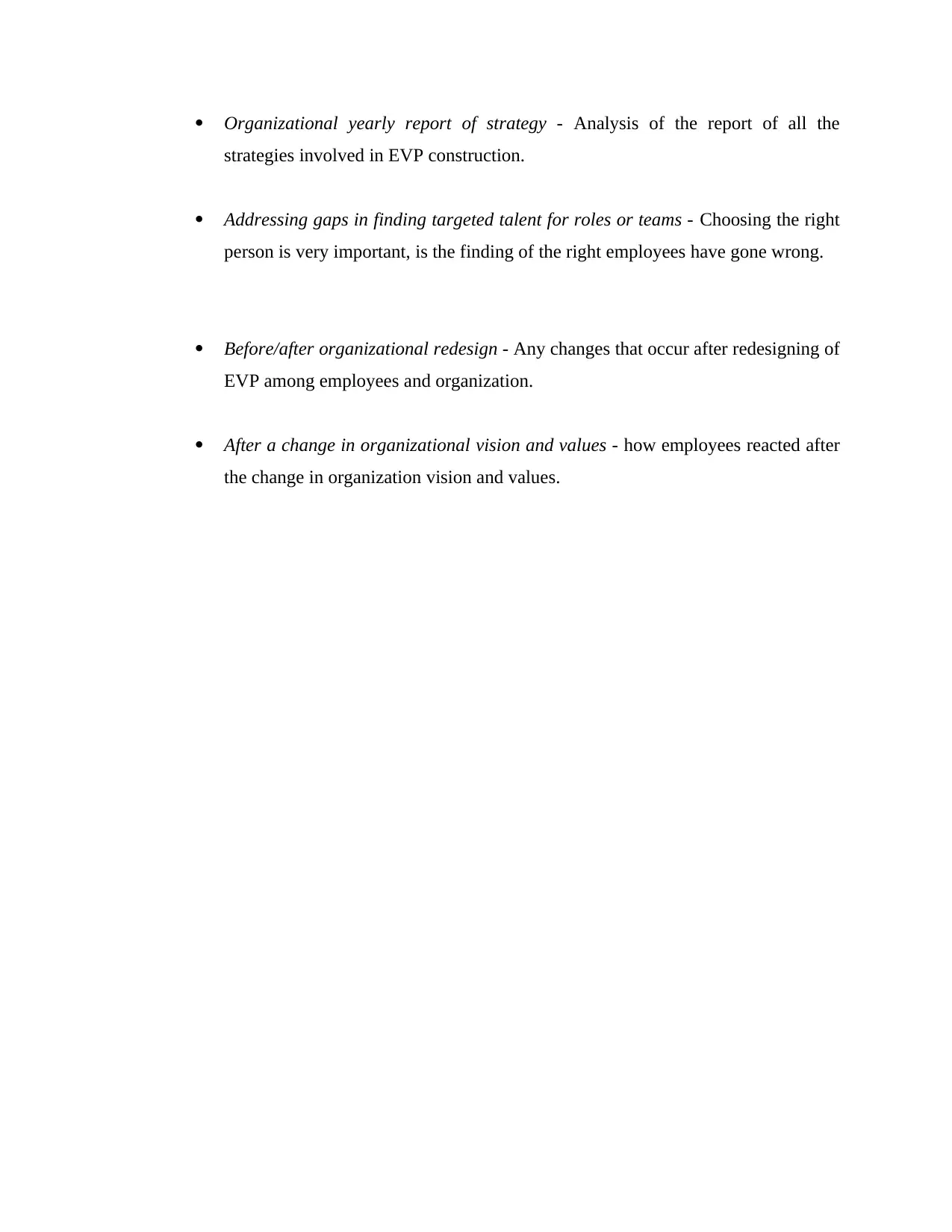
Organizational yearly report of strategy - Analysis of the report of all the
strategies involved in EVP construction.
Addressing gaps in finding targeted talent for roles or teams - Choosing the right
person is very important, is the finding of the right employees have gone wrong.
Before/after organizational redesign - Any changes that occur after redesigning of
EVP among employees and organization.
After a change in organizational vision and values - how employees reacted after
the change in organization vision and values.
strategies involved in EVP construction.
Addressing gaps in finding targeted talent for roles or teams - Choosing the right
person is very important, is the finding of the right employees have gone wrong.
Before/after organizational redesign - Any changes that occur after redesigning of
EVP among employees and organization.
After a change in organizational vision and values - how employees reacted after
the change in organization vision and values.
Paraphrase This Document
Need a fresh take? Get an instant paraphrase of this document with our AI Paraphraser
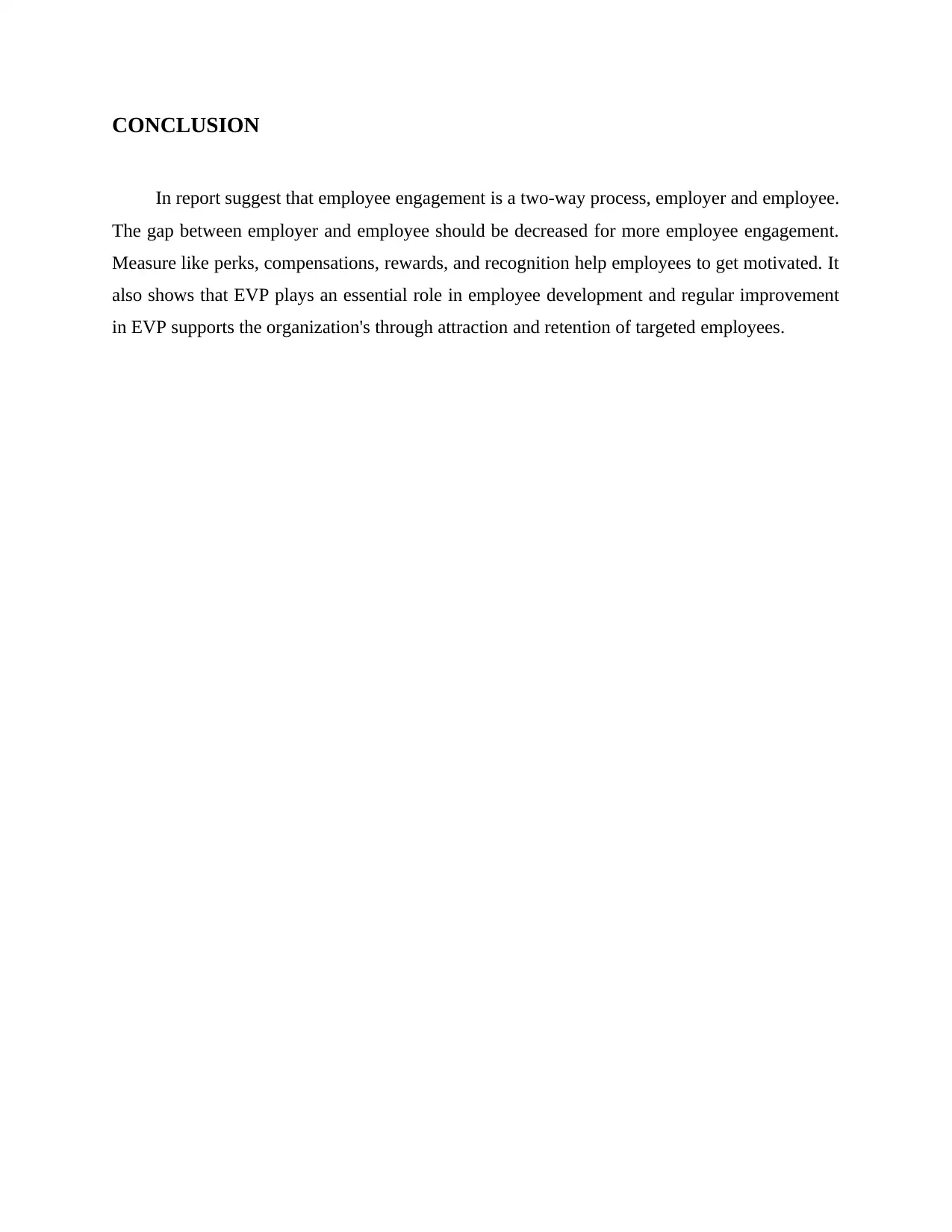
CONCLUSION
In report suggest that employee engagement is a two-way process, employer and employee.
The gap between employer and employee should be decreased for more employee engagement.
Measure like perks, compensations, rewards, and recognition help employees to get motivated. It
also shows that EVP plays an essential role in employee development and regular improvement
in EVP supports the organization's through attraction and retention of targeted employees.
In report suggest that employee engagement is a two-way process, employer and employee.
The gap between employer and employee should be decreased for more employee engagement.
Measure like perks, compensations, rewards, and recognition help employees to get motivated. It
also shows that EVP plays an essential role in employee development and regular improvement
in EVP supports the organization's through attraction and retention of targeted employees.
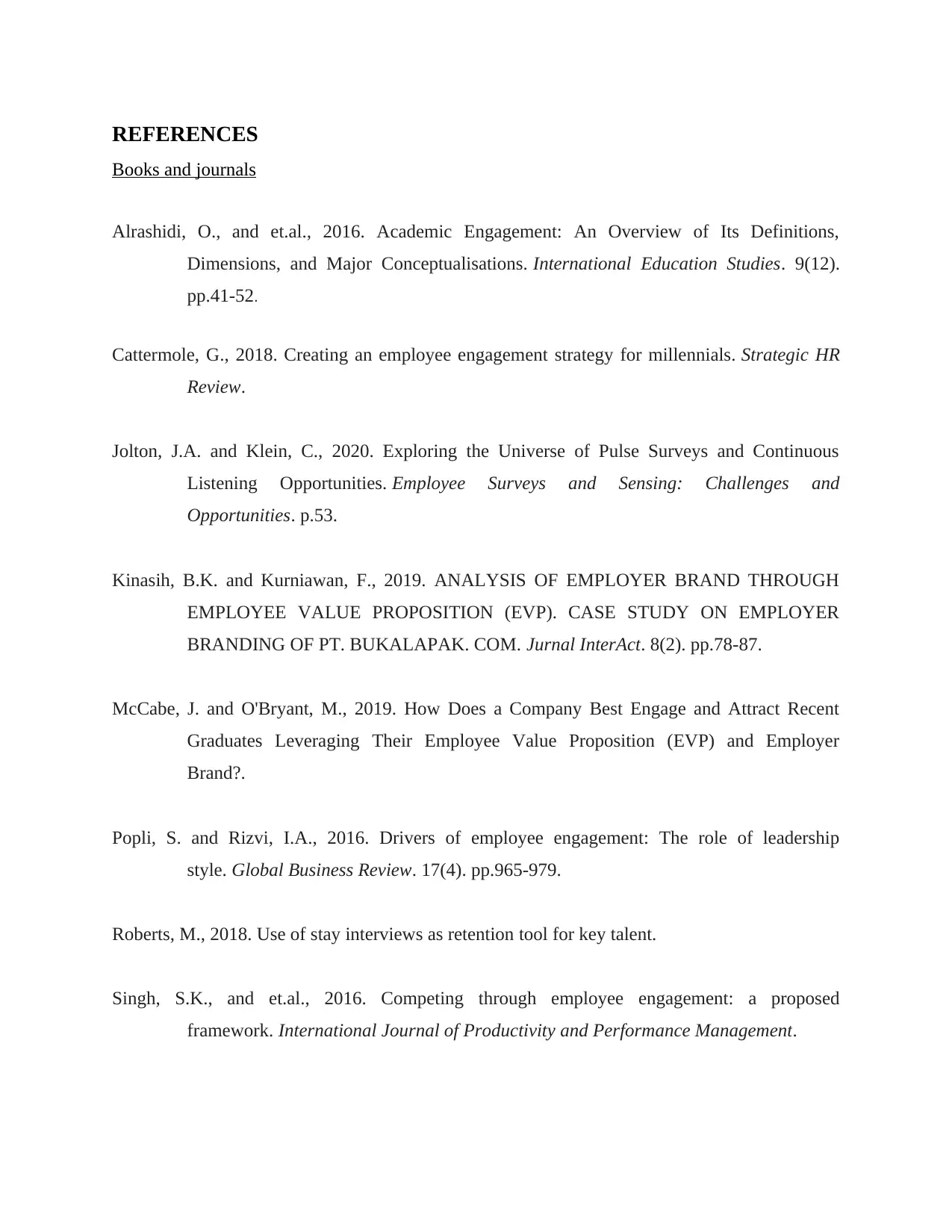
REFERENCES
Books and journals
Alrashidi, O., and et.al., 2016. Academic Engagement: An Overview of Its Definitions,
Dimensions, and Major Conceptualisations. International Education Studies. 9(12).
pp.41-52.
Cattermole, G., 2018. Creating an employee engagement strategy for millennials. Strategic HR
Review.
Jolton, J.A. and Klein, C., 2020. Exploring the Universe of Pulse Surveys and Continuous
Listening Opportunities. Employee Surveys and Sensing: Challenges and
Opportunities. p.53.
Kinasih, B.K. and Kurniawan, F., 2019. ANALYSIS OF EMPLOYER BRAND THROUGH
EMPLOYEE VALUE PROPOSITION (EVP). CASE STUDY ON EMPLOYER
BRANDING OF PT. BUKALAPAK. COM. Jurnal InterAct. 8(2). pp.78-87.
McCabe, J. and O'Bryant, M., 2019. How Does a Company Best Engage and Attract Recent
Graduates Leveraging Their Employee Value Proposition (EVP) and Employer
Brand?.
Popli, S. and Rizvi, I.A., 2016. Drivers of employee engagement: The role of leadership
style. Global Business Review. 17(4). pp.965-979.
Roberts, M., 2018. Use of stay interviews as retention tool for key talent.
Singh, S.K., and et.al., 2016. Competing through employee engagement: a proposed
framework. International Journal of Productivity and Performance Management.
Books and journals
Alrashidi, O., and et.al., 2016. Academic Engagement: An Overview of Its Definitions,
Dimensions, and Major Conceptualisations. International Education Studies. 9(12).
pp.41-52.
Cattermole, G., 2018. Creating an employee engagement strategy for millennials. Strategic HR
Review.
Jolton, J.A. and Klein, C., 2020. Exploring the Universe of Pulse Surveys and Continuous
Listening Opportunities. Employee Surveys and Sensing: Challenges and
Opportunities. p.53.
Kinasih, B.K. and Kurniawan, F., 2019. ANALYSIS OF EMPLOYER BRAND THROUGH
EMPLOYEE VALUE PROPOSITION (EVP). CASE STUDY ON EMPLOYER
BRANDING OF PT. BUKALAPAK. COM. Jurnal InterAct. 8(2). pp.78-87.
McCabe, J. and O'Bryant, M., 2019. How Does a Company Best Engage and Attract Recent
Graduates Leveraging Their Employee Value Proposition (EVP) and Employer
Brand?.
Popli, S. and Rizvi, I.A., 2016. Drivers of employee engagement: The role of leadership
style. Global Business Review. 17(4). pp.965-979.
Roberts, M., 2018. Use of stay interviews as retention tool for key talent.
Singh, S.K., and et.al., 2016. Competing through employee engagement: a proposed
framework. International Journal of Productivity and Performance Management.
⊘ This is a preview!⊘
Do you want full access?
Subscribe today to unlock all pages.

Trusted by 1+ million students worldwide
1 out of 13
Related Documents
Your All-in-One AI-Powered Toolkit for Academic Success.
+13062052269
info@desklib.com
Available 24*7 on WhatsApp / Email
![[object Object]](/_next/static/media/star-bottom.7253800d.svg)
Unlock your academic potential
Copyright © 2020–2025 A2Z Services. All Rights Reserved. Developed and managed by ZUCOL.



